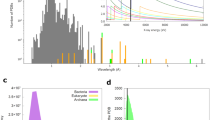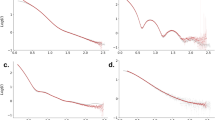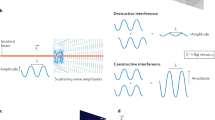Abstract
The growing importance of synchrotron radiation for structural biology can be charted from the construction and use of an X-ray beam line at DESY in Hamburg, Germany in 1970, to the completion of the three third generation synchrotrons in France, the USA and Japan in the 1990s.
This is a preview of subscription content, access via your institution
Access options
Subscribe to this journal
Receive 12 print issues and online access
$189.00 per year
only $15.75 per issue
Buy this article
- Purchase on Springer Link
- Instant access to full article PDF
Prices may be subject to local taxes which are calculated during checkout

Similar content being viewed by others
References
Reedy, M.K., Holmes, K.C. & Tregear, R.T. Induced changes in the orientation of the cross-bridges of glycerinated insect flight muscle. Nature 207, 1276–1280 (1965).
Huxley, H.E. The mechanism of muscular contraction. Science 164, 1356–1366 (1969).
Huxley, H.E. & Brown, W. The low angle X-ray diagram of vertebrate striated muscle and its behaviour during contraction and rigor. J. Mol. Biol. 30, 383–434 (1967).
Cauchois, Y., Bonnelle, C. & Missoni, G. Rayonnement électromagnétique — Premiers spectres X du rayonnement d'orbite du synchrotron de Frascati. Compte-rendu hebd. Séanc. Acad. Sci. Paris 257, 409–412 (1963).
Schwinger, J. On the classical radiation of accelerated electrons. Phys. Rev. 12, 1912–1925 ( 1949).
Rosenbaum, G., Holmes, K.C. & Witz, J. Synchrotron radiation as a source for X-ray diffraction. Nature 230, 434–437 (1971).
Barrington Leigh, J. & Rosenbaum, G. A report on the application of synchroton radiaton to low-angle scattering. J. Appl. Crystallogr. 7, 117–121 (1974).
Barrington Leigh, J. & Rosenbaum, G. Synchrotron X-ray sources: a new tool in biological structural and kinetic analysis. Annu. Rev. Biophys. Bioeng. 5, 239– 270 (1976).
Huxley, H.E. et al. Millisecond time-resolved changes in X-ray reflections from contracting muscle during rapid mechanical transients, recorded using synchrotron radiation. Proc. Natl. Acad. Sci. USA 78, 2297–2301 (1981).
Harmsen, A., Leberman, R. & Schulz, G.E. Comparison of protein crystal diffraction patterns and absolute intensities from synchrotron and conventional X-ray sources. J. Mol. Biol. 104, 311–314 (1976).
Phillips, J.C., Wlodawer, A., Yevitz, M.M. & Hodgson, K.O. Applications of synchrotron radiation to protein crystallography: preliminary results. Proc. Natl. Acad. Sci. USA 73, 128–132 (1976).
Garman, E., F. & Scheider, T.R. Macromolecular crystallography. J. Appl. Crystallogr. 30, 211–237 (1997).
Teng, T.Y. Mounting of crystals for macromolecular crystallography in a free-standing thin film. J. Appl. Crystallogr. 23, 387–391 (1990).
Hendrickson, W. Determination of macromolecular structures from anomalous diffraction of synchrotron radiation. Science 254, 51– 58 (1991).
Author information
Authors and Affiliations
Corresponding author
Rights and permissions
About this article
Cite this article
Holmes, K. From rare to routine. Nat Struct Mol Biol 5 (Suppl 8), 618–619 (1998). https://doi.org/10.1038/1312
Issue Date:
DOI: https://doi.org/10.1038/1312



